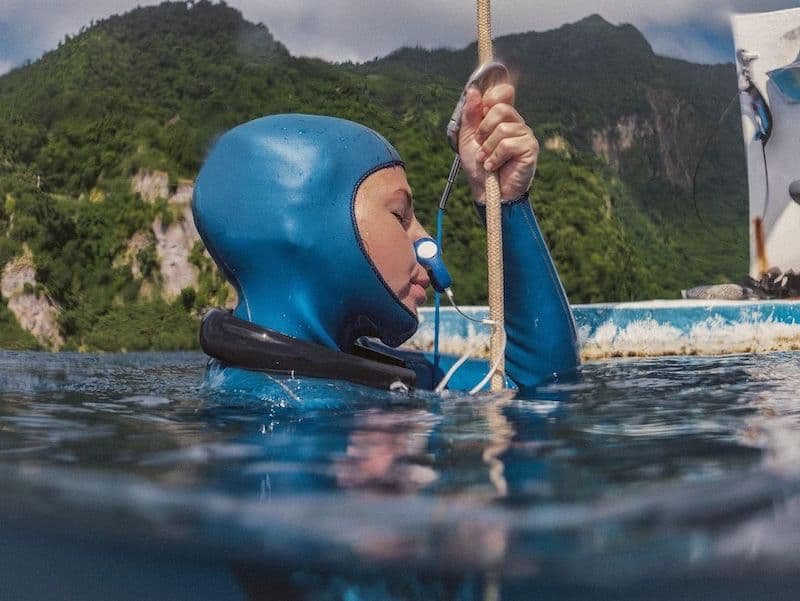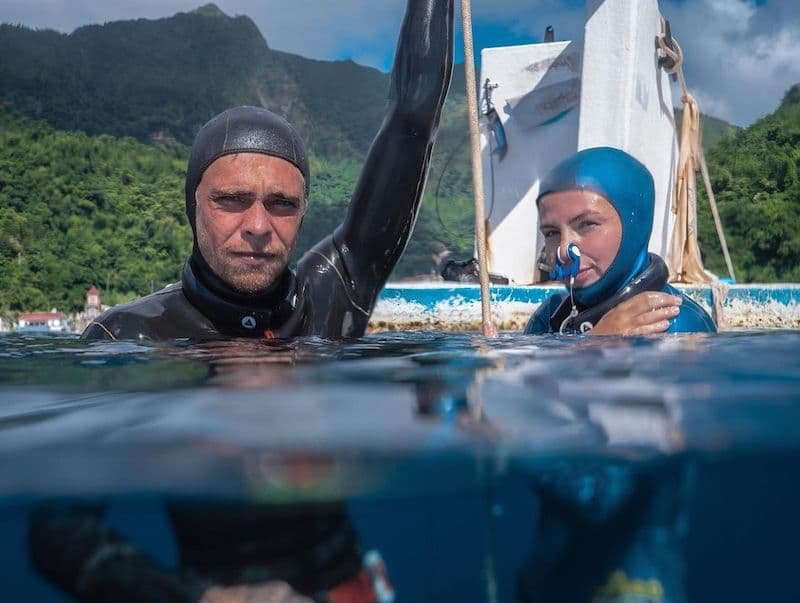As my diving has developed, new terms that were once foreign to me have now made their way into my vocabulary as I’ve studied and trained apnea. This includes the term nose clip. It’s the one piece of equipment that I probably get questioned about the most frequently. I want to discuss why it is we clip our noses when we dive, and why you should begin to use one as soon as possible.
There are really several reasons we use a clip rather than a mask. Relaxation, air management, reduced risk of a squeeze, and simply just one less piece of equipment to worry about equalizing. When you freedive, any airspace is going to compress more and more the deeper you dive. This includes your mask. Just like if you were swimming to the bottom of a pool or flying in a plane, the change of pressure compresses our air space resulting in pressure in our middle ear. That is why we plug our noses and “pop” our ears. In order to manage that change of pressure. As you descend, naturally, your mask will begin to suction to your face as it compresses with the increasing water pressure. We equalize that air space constantly by pinching our noses and letting out a small amount of air into the mask to avoid that suction, resulting in a mask squeeze. When you are wearing a nose clip, there is no mask to worry about, this makes for a less distracted dive. For recreational freedivers, most, if not all of the training is done wearing a mask. Learning to dive effortlessly with a mask is a really crucial part of training as a freediver as well. Not just because it makes your own diving better, but because you don’t want to worry about any discomforts while you’re safetying a buddy. Wearing a mask and improving your deep Frenzel will also be a very valuable skill as time goes on.

The thing about the nose clip is that it gives most people a hard time right off the bat. Including myself. If I could go back to the beginning of my own training there are only a few things I would actually change. One of those things would be using a nose clip much earlier on. Regardless, I think these setbacks or failures are vital in order to grow as a freediver. I personally believe that most people should be using a clip both in and out of the water as soon as they can. Why I feel strongly about introducing yourself to a nose clip sooner rather than later is for one simple reason, nose clips are very strange! They take a lot of getting used to. When I first started using a nose clip I was a 40-meter diver. I had a coach at the time who was giving me some very difficult training. They got even more uncomfortable when I wore the clip for the first time! Lucky for me, learning the hard way worked well and after about a week of serious difficulty, I was successfully equalizing to 40m and slowly learning to enjoy the nose clip.
Starting training with a nose clip doesn’t mean diving depth with it straight away. There are several ways to familiarize yourself with the sensations of a nose clip to make the transition easier. The first step can be wearing your nose clip during statics, both wet and dry. In these phases, get used to just having it on your face and opening your eyes underwater without a mask. For most of us, it takes time to get familiar with water hitting the parts of the face that are typically covered. During wet statics, do a session only with comfortable holds. Adjust the nose clip several times during your session to find what feels the most comfortable. Remember, you do not have to weld the nose clip tightly on your face, this will likely lead to equalizing with more force than you really need. Play around with having your nose clip on as loose as possible, and slowly increase the tightness as needed.

If you can, try out all of the different shapes the nose clip comes in. Sometimes the shape you like will depend on the type of nose you have. Once you find the setting and position that is right for you, you can move on to depth. Before you even start to dive, you can do a simple warm-up that we call “facial immersion.” All you have to do is hold on to the side of your buoy or platform with your nose clip on, your snorkel in your mouth, and ease into your relaxation phase. To get familiar with the sensation of water streaming on your face in this exercise, you can wave your hand to create movement in the water that hits your face. Practice this with your eyes both open and closed for 5-10 minutes.
When your session begins, I would recommend starting with slow FIM warm-ups. One with your mask and one with your nose clip. If you’re feeling comfortable, try a light hang at the bottom. When we introduce any type of new equipment. It’s important to take it slow and avoid seriously negative self-talk during the transition. As your sessions continue, introduce the nose clip to different drills that you regularly do in your training. For myself, I found that shallow hangs and repeating the same depth over and over was the best way to practice using my nose clip. During the pursuit of depth, your nose clip will become your best friend. You can use it to practice advanced freediving techniques such as mouthfill and packing as your diving advances. So if you want to improve your diving game today, purchase a nose clip and watch as your diving is taken to the next level!